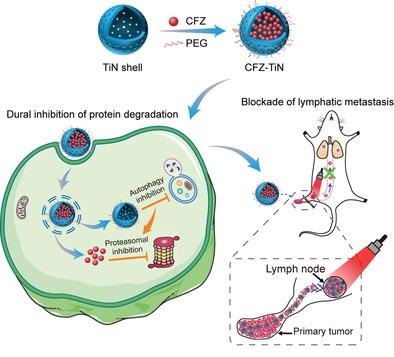Our official English website, www.x-mol.net, welcomes your feedback! (Note: you will need to create a separate account there.)
Chemo-Phototherapy with Carfilzomib-Encapsulated TiN Nanoshells Suppressing Tumor Growth and Lymphatic Metastasis
Small ( IF 13.3 ) Pub Date : 2022-06-24 , DOI: 10.1002/smll.202200522 Xuan Wu 1 , Le Wang 2 , Yan-Neng Xu 1, 3 , Jian-Li Chen 1 , Kathy Qian Luo 4 , Ming-Heng Yuan 4 , Jie Li 1 , Gang Yuan 1, 3 , Ze-Yun Gu 1 , Xiao-Hui Jia 1 , Xiuping Chen 5 , Xiao-Ming Zhu 1 , Ruibin Jiang 2
Small ( IF 13.3 ) Pub Date : 2022-06-24 , DOI: 10.1002/smll.202200522 Xuan Wu 1 , Le Wang 2 , Yan-Neng Xu 1, 3 , Jian-Li Chen 1 , Kathy Qian Luo 4 , Ming-Heng Yuan 4 , Jie Li 1 , Gang Yuan 1, 3 , Ze-Yun Gu 1 , Xiao-Hui Jia 1 , Xiuping Chen 5 , Xiao-Ming Zhu 1 , Ruibin Jiang 2
Affiliation

|
The design of nanomedicine for cancer therapy, especially the treatment of tumor metastasis has received great attention. Proteasome inhibition is accepted as a new strategy for cancer therapy. Despite being a big breakthrough in multiple myeloma therapy, carfilzomib (CFZ), a second-in-class proteasome inhibitor is still unsatisfactory for solid tumor and metastasis therapy. In this study, hollow titanium nitride (TiN) nanoshells are synthesized as a drug carrier of CFZ. The TiN nanoshells have a high loading capacity of CFZ, and their intrinsic inhibitory effect on autophagy synergistically enhances the activity of CFZ. Due to an excellent photothermal conversion efficiency in the second near-infrared (NIR-II) region, TiN nanoshell-based photothermal therapy further induces a synergistic anticancer effect. In vivo study demonstrates that TiN nanoshells readily drain into the lymph nodes, which are responsible for tumor lymphatic metastasis. The CFZ-loaded TiN nanoshell-based chemo-photothermal therapy combined with surgery offers a remarkable therapeutic outcome in greatly inhibiting further metastatic spread of cancer cells. These findings suggest that TiN nanoshells act as an efficient carrier of CFZ for realizing enhanced outcomes for proteasome inhibitor-based cancer therapy, and this work also presents a “combined chemo-phototherapy assisted surgery” strategy, promising for future cancer treatment.
中文翻译:

卡非佐米封装的 TiN 纳米壳化疗光疗抑制肿瘤生长和淋巴转移
用于癌症治疗,特别是肿瘤转移治疗的纳米药物的设计受到了极大的关注。蛋白酶体抑制被认为是癌症治疗的新策略。尽管卡非佐米(CFZ)这一二类蛋白酶体抑制剂在多发性骨髓瘤治疗上取得了重大突破,但其对于实体瘤和转移瘤的治疗仍不能令人满意。在这项研究中,合成了空心氮化钛(TiN)纳米壳作为CFZ的药物载体。TiN纳米壳具有较高的CFZ负载能力,其对自噬的内在抑制作用协同增强CFZ的活性。由于在第二近红外(NIR-II)区域具有优异的光热转换效率,基于TiN纳米壳的光热疗法进一步诱导协同抗癌作用。体内研究表明,TiN 纳米壳很容易流入淋巴结,从而导致肿瘤淋巴转移。负载 CFZ 的 TiN 纳米壳化学光热疗法与手术相结合,在很大程度上抑制癌细胞的进一步转移扩散方面提供了显着的治疗效果。这些发现表明,TiN纳米壳可以作为CFZ的有效载体,以实现基于蛋白酶体抑制剂的癌症治疗的增强效果,并且这项工作还提出了“联合化疗光疗辅助手术”策略,为未来的癌症治疗带来了希望。
更新日期:2022-06-24
中文翻译:

卡非佐米封装的 TiN 纳米壳化疗光疗抑制肿瘤生长和淋巴转移
用于癌症治疗,特别是肿瘤转移治疗的纳米药物的设计受到了极大的关注。蛋白酶体抑制被认为是癌症治疗的新策略。尽管卡非佐米(CFZ)这一二类蛋白酶体抑制剂在多发性骨髓瘤治疗上取得了重大突破,但其对于实体瘤和转移瘤的治疗仍不能令人满意。在这项研究中,合成了空心氮化钛(TiN)纳米壳作为CFZ的药物载体。TiN纳米壳具有较高的CFZ负载能力,其对自噬的内在抑制作用协同增强CFZ的活性。由于在第二近红外(NIR-II)区域具有优异的光热转换效率,基于TiN纳米壳的光热疗法进一步诱导协同抗癌作用。体内研究表明,TiN 纳米壳很容易流入淋巴结,从而导致肿瘤淋巴转移。负载 CFZ 的 TiN 纳米壳化学光热疗法与手术相结合,在很大程度上抑制癌细胞的进一步转移扩散方面提供了显着的治疗效果。这些发现表明,TiN纳米壳可以作为CFZ的有效载体,以实现基于蛋白酶体抑制剂的癌症治疗的增强效果,并且这项工作还提出了“联合化疗光疗辅助手术”策略,为未来的癌症治疗带来了希望。



























 京公网安备 11010802027423号
京公网安备 11010802027423号